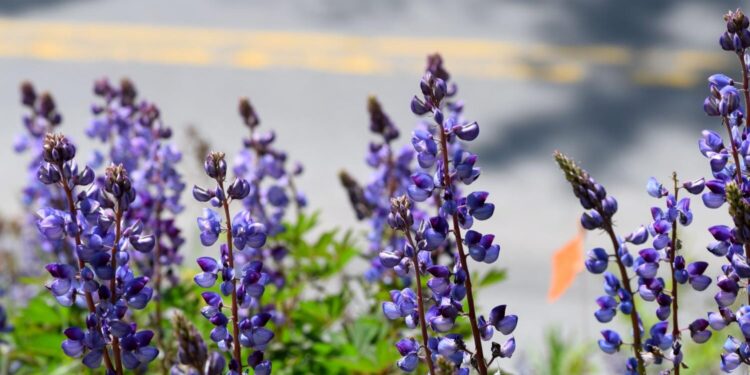Wild lupine, a plant of conservation concern throughout most of its natural range in eastern North America, grows along a road in Pennsylvania. Credit: Isabelle Petitta
Managing forest edge habitats to maintain a gradient of forest cover and plant density could be critical to the conservation of some threatened native plant species such as wild lupine, according to Penn State researchers.
Edge habitats created by natural or human-made disturbances, including corridors along roads and utility rights-of-way, provide excellent opportunities to encourage the establishment and reproduction of rare native plants, reported researchers in a new study published in Plant ecology.
The authors reviewed and synthesized results from 33 published studies examining the biology and management of wild lupine and associated plants and insects. Their case study suggests that land management, including prescribed burning, mowing, and mechanical thinning, can promote the conservation of wild lupine and other forest edge plants.
“Most eastern ecosystems are managed to maintain dense, forested habitats,” said lead author Isabella Petitta, a master’s candidate in Penn State’s Intercollegiate Graduate Program in Ecology. “The lack of disturbance in these forests generates homogenous, closed forests that result in habitat losses for early successional plants such as wild lupine.”
In nearly 60% of its native range in eastern North America, wild lupine is a species of conservation concern and requires management strategies for its protection, researchers said .
Petitta, a graduate researcher at the U.S. National Science Foundation, explained that one of the primary habitats for wild lupine is oak savannah, an early successional habitat with less than 50 percent tree cover. Considered transition zones between grasslands and forests, oak savannas provide a mix of forest cover that allows for diversity of plant communities and microhabitats.
Wild lupine prefers open or partially shaded conditions with 50% or less tree cover. It grows about 8 to 24 inches tall and each mature stem produces between 30 and 50 white, light pink, purple or blue flowers. The pollinator-dependent perennial has been considered an indicator species for oak savannah habitat quality.
A patch of wild lupine grows along a forest edge, in a road and utility right-of-way. With the plant’s original habitat declining, 80 percent of wild lupine populations in Pennsylvania are located along human infrastructure rights-of-way, researchers said. Credit: Nash Turley
“But fire suppression, development, demand for timber, conversion to agricultural land and other factors have reduced oak savannas to among the most endangered habitats in North America,” Petitta said, noting that oak savannahs cover only about 0.02% of their original area. area.
Study co-author Autumn Sabo, an assistant professor of biology at Penn State Beaver and Petitta’s co-advisor, noted that the loss of oak savannah habitat means that forest edges maintained for infrastructure are become an important habitat for rare plant species.
“In 2017, for example, there were more than 700,000 miles of high-voltage transmission lines and 6.5 million miles of local electric distribution lines in the United States,” she said. “And in Pennsylvania, about 80 percent of wild lupine populations are located along road, trail, railroad, gas or power line rights-of-way.”
Wild lupine habitat typically supports other early successional, grassland and forest edge plants, some of which may benefit from wild lupine’s ability to fix atmospheric nitrogen in the soil, the researchers said.
“Wild lupine habitats also support a diverse community of insects, and the flowers produce pollen and nectar that attract pollinating insects and visitors,” said study co-author Margarita López-Uribe, professor Associate Professor of Entomology and Lorenzo L. Langstroth Early Career Professor at Columbia University. College of Agricultural Sciences.
López-Uribe, who also co-advises Petitta, pointed out that roadsides and power line right-of-ways adjacent to the forest edge are considered favorable habitats for pollinators because they provide various floral resources and travel corridors.
“In addition, the vegetative parts of the wild lupine serve as a host for the larvae of three butterflies of conservation concern – the endangered Karner blue butterfly, the dusky wing persius and the frosted elf – and a moth, lupine leafroller,” she said. “The decline of wild lupine habitat is directly linked to the decline of these species.”
Researchers said several environmental conditions are necessary to increase wild lupine cover and density, including light intensity levels around 65% of full sun, canopy cover providing intermediate or partial shade, and minimal presence of leaf litter. Management practices that can achieve these conditions, they suggested, include prescribed burning, herbicide application, mowing and mechanical felling of trees.
In addition to habitat management, wild lupine populations can be improved through seeding and transplanting, the researchers added. But they recommended that land managers focus on increasing existing populations before attempting to establish new ones.
The researchers cautioned that although various edge habitat management practices have been shown to benefit early successional plants, these methods must be planned and timed properly to be effective, and additional studies are needed to refine the recommendations.
“Wild lupine provides the opportunity to study and optimize management of rare plants in early successional habitats, including artificial habitats such as power line right-of-ways and roadsides,” Petitta said . “The restoration and management of these edge habitats is essential to the conservation of wild lupine and its associated plant and insect communities.”
More information:
Isabella R. Petitta et al, Biology and management of wild lupine (Lupinus perennis L.): a case study for the conservation of rare plants at the edge of habitat, Plant ecology (2023). DOI: 10.1007/s11258-023-01371-9
Provided by Pennsylvania State University
Quote: Edge habitats along roads and power lines can be essential for conserving rare plants (February 1, 2024) retrieved February 1, 2024 from
This document is subject to copyright. Except for fair use for private study or research purposes, no part may be reproduced without written permission. The content is provided for information only.



